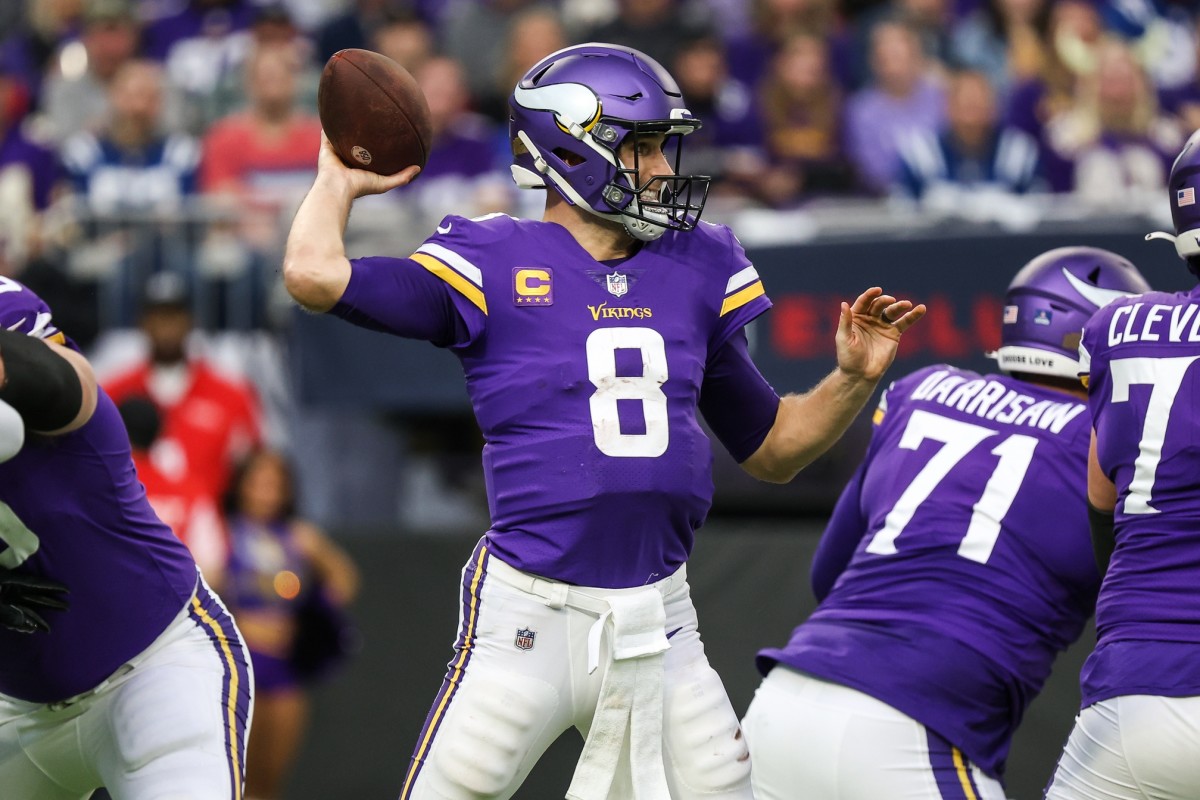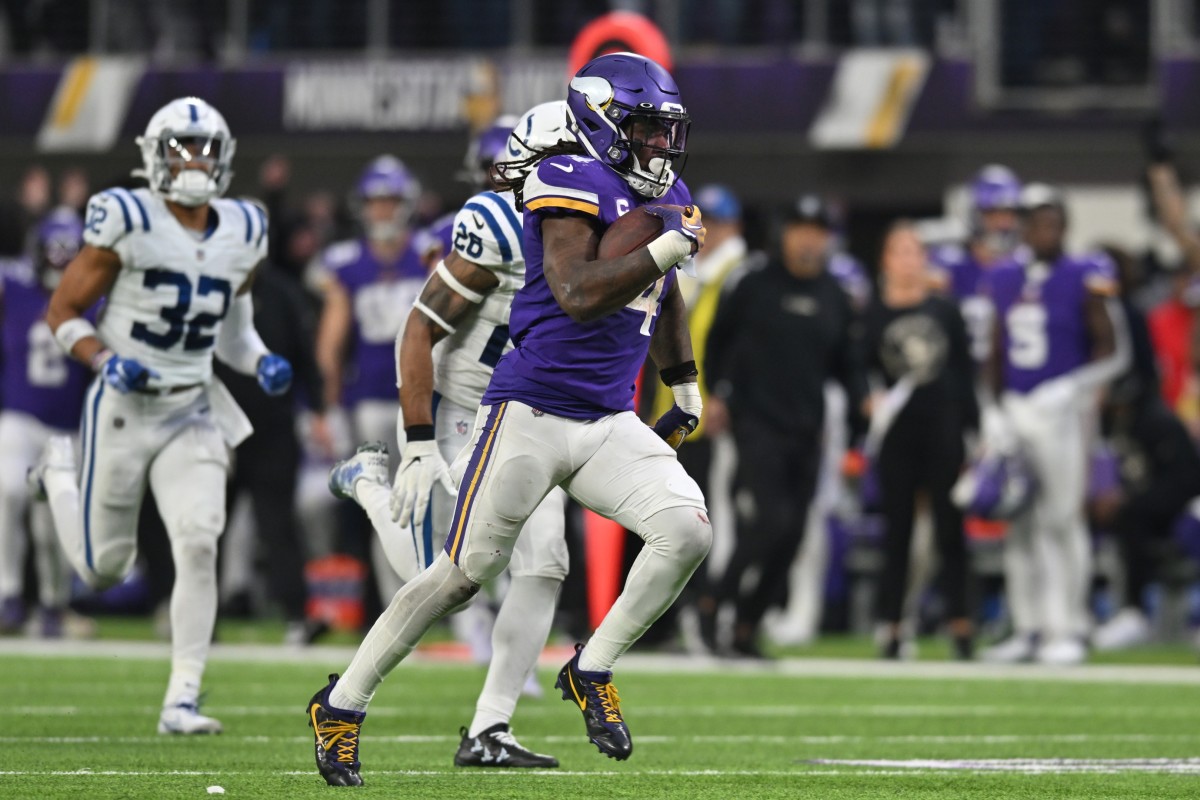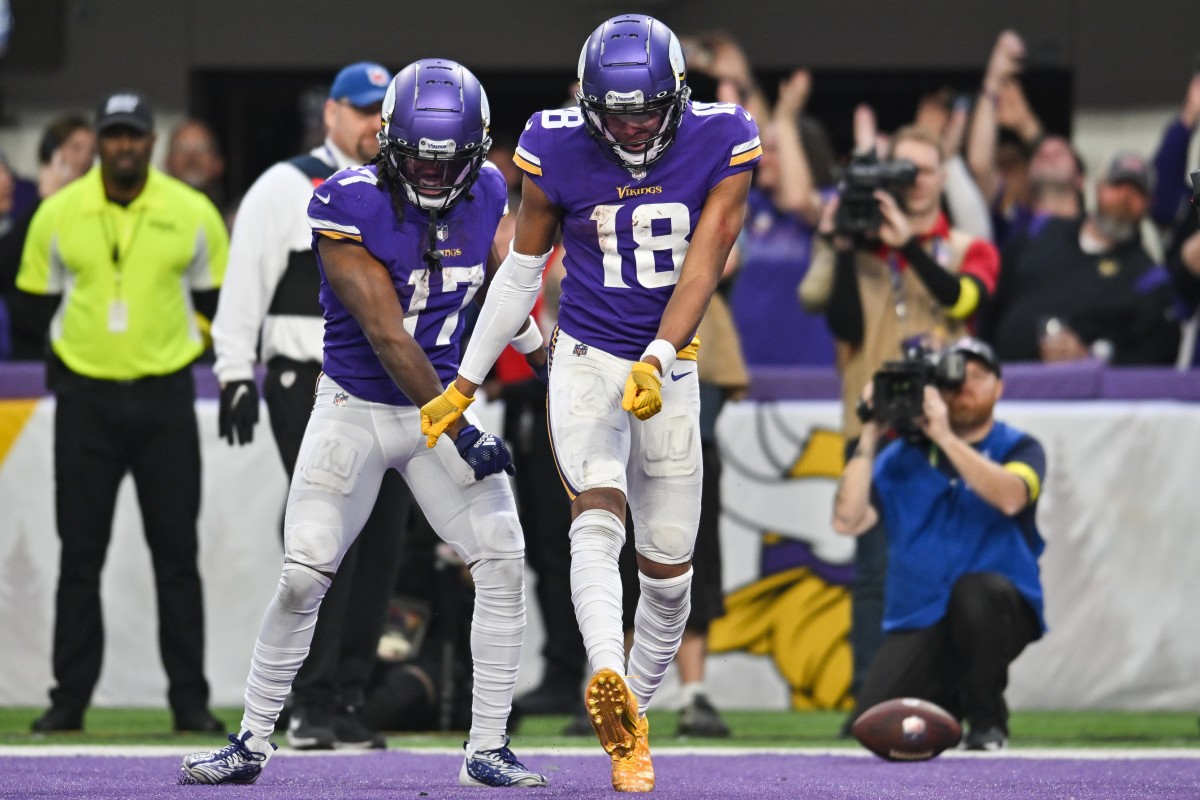Kirk Cousins Gets Real About What Vikings Players Told Each Other at Halftime Ahead of Greatest Comeback in NFL History
This wasn’t Kirk Cousins’s first time piloting this kind of comeback, even this year. And even if this one was, at least statistically, unprecedented over 103 seasons of NFL games.
So as the Vikings quarterback left U.S. Bank Stadium in downtown Minneapolis on Saturday afternoon—wearing a loud purple sport coat with Vikings logos and his family in tow—he thought about another comeback. Only this one was with another team, and with another coach, and perfectly encapsulated what it took to rebound from a 33–0 deficit to the Colts and turn it into a 39–36 overtime win.
“Yeah, I remember when we came back against Tampa in 2015—we were down 24–0 and came back and won 31–30,” Cousins says. “Jay [Gruden] texted me that night, after the game, and he just said, Great job. That doesn’t happen to average people. That always stuck with me, that you gotta be uncommon to be able to do something like that. And so I have the same thought going through my mind, that Jay texted seven years ago, after we won today.

“That just doesn’t happen to average people. And this team has been uncommon and has displayed an uncommon level of chemistry with one another, toughness, and I think it was on display today.”
What everyone witnessed Saturday was more than just uncommon.
It legitimately was a first, and not just for a player, or a team, but the whole league.
Maybe the Vikings making history won’t guarantee them much beyond that they pulled off a comeback that, 30 years later, eclipsed the Bills-Oilers ’92 wild-card playoff game as the NFL’s biggest ever. On the other hand, as Cousins says, it revealed plenty about a team that was somehow still doubted coming into the game against the Colts at 10–3.
And as Cousins tells the story, that quality the Vikings have—the same one that helped fuel a furious comeback five weeks ago in Buffalo—showed up in spades in the locker room at halftime with Minnesota down 33–0.
The first half had gone about as poorly as possible, and that’s no overstatement. “There’s no explanation,” Cousins says. “We made it really hard on ourselves.” A long return off the opening kickoff positioned Indianapolis to take a 3–0 lead out of the gate. A blocked punt returned for a touchdown made it 10–0. A Dalvin Cook fumble gave the Colts a short field to make it 17–0. Two fourth-down stops, one on a fake punt, led to two more Indianapolis field goals. A pick-six made it 30–0. And a two-minute drive led to another field to get it to 33–0 at the half.
Yet, no one on the home team was shaken. In fact, veteran corner Patrick Peterson was saying, over and over, All we need is five touchdowns. Offensive line coach Chris Kuper, in another corner of the locker room, was saying pretty much the same thing.
“[Kuper] said it to me before we started the second half. He said, Let’s score 35 unanswered,” Cousins says. “I thought, I mean, that’d be great. But that doesn’t just happen.”
Through 30 minutes of chipping away, and that inexplicable belief, it did on Saturday.
And Cousins took us through the steps he, and his team, took along the way to get there.
• The second half actually didn’t start according to plan for the Vikings—Cook was dropped for a loss on the first play and Cousins was sacked, and Minnesota went three-and-out and punted. So, going into the team’s second possession after the half, the Vikings clearly needed a spark. And one of the afternoon’s biggest stars—K.J. Osborn—would give it to them on a second-and-12 on the Vikings’ 35 with 9:42 left in the third.
“Their coverage might’ve just been a little bit misaligned there, because he got behind the linebacker and there was no safety in that area of the field,” Cousins says. “And I think they would tell you that they needed to have somebody there. So K.J. was just kinda running to open grass and I just put it out there for him. We had connected earlier on a big play that they ruled a completion, and then the Colts challenged it and it came back as an incompletion.
“That was kind of additional frustration where, even when we got something going, we couldn’t get it to hold up. And then the same for a couple touchdowns that Chandon Sullivan had that we thought were touchdowns. Instead, they turned out to be that the whistle got blown and the play was dead. There were several things to overcome in addition to the deficit.”
The two negated would-be defensive touchdowns from Sullivan may not have had more than an intangible benefit. The Osborn one—a 40-yard catch that was challenged and overturned—did, though. On the play Cousins described, Osborn got lost enough in Indy’s coverage to generate 63 yards on the play and get to the Colts’ 4-yard line. Three plays later, he was catching another ball from Cousins, this one a two-yard touchdown to make it 33–7.

• From there, the game changed—and that was evident right away, with the Vikings taking their next possession 75 yards in eight plays without having to convert a single third down. On the drive after that, they covered 61 yards in six plays, only needing one third down to make it to the end zone, with one coming on an eight-yard touchdown pass from Cousins to Justin Jefferson.
And it was that easy because of plays made moving the ball methodically and in chunks—with none more important than Jefferson roaring through the Indy defense for 20 yards on the first play of the fourth quarter right after Cousins took an untimely sack.
“It was a choice route, where he just broke out,” Cousins says. “So that was just a great run after catch, and after that, they kinda started to play more vision by the corner to make sure that if he broke out, that the corner would be there. It was a little bit of a cat-and-mouse game there, trying to feel when they were falling off and when they were letting us break out without any threat of an outside defender. So we were just trying to play through that as the game went on.”
Which, in doing so provided another example of how the Vikings are growing and another reason why the Colts’ lead was slowly shrinking, in this case, to 36–21.
• After that, Cousins threw a pick—Jalen Reagor stopped running on an over route, and Colts safety Rodney Thomas didn’t, making the easy interception. The Vikings defense then forced another three-and-out to get the offense the ball back at the 50.
To follow: Completions to Adam Thielen (19 yards) and Osborn (17), a defensive pass interference drawn by Osborn to put the ball on the 1-yard line, and a touchdown pass to Thielen in the back of the end zone on third-and-goal to make it 36–28.
“Yeah, I just have total confidence in Adam and K.J.,” Cousins says. “The ball goes to Justin—I think a lot of that is just the scheme and coaches, trying to make sure Justin gets opportunities and gets the ball. But when the reads can take me to K.J. and Adam, I love it, and I like to get all three of them involved.”
Cousins continued talking about Osborn and the 25-year-old receiver’s 10-catch, 157-yard day. “My issue with K.J. is he’s not getting the ball enough. He’s capable of having the day he had today every week. Not everybody can do that. If you’re gonna give it to Justin, then K.J. and Adam, I guess, you end up not being able to participate as much. But K.J. is capable of that every week, and he’s an elite receiver and I just wish we could get him the ball more.”
Cousins doesn’t just have a talented group of receivers. He also has Dalvin Cook, who can break off a long run or catch at any time, and that’s exactly what he did.
• The Vikings got the ball back at their own 36 with 2:28 left. And this drive would take no time at all, or even much sophistication—O’Connell liked a screen for that situation, and the idea of putting the ball in Cook’s hands, and that was that.
Cook took Cousins’s pass and ran through the Colts for a 64-yard touchdown. T.J. Hockenson caught the two-pointer (he was on the backside of Cousins’s progression, and the protection held up to get him the ball), and the game was tied at 36.
“I mean, it has to be well-blocked for that to hit,” Cousins says. “But at some point, he’s gotta take it from there and make the play. Combination of guys getting their blocks and then Dalvin just being special. It’s one thing to get a 20-yard gain or a 30-yard gain, but to be able to take it the distance and finish with a touchdown is such a big play. It was a great call. We needed to hit him with a screen at that point, and so it was great timing to be able to make that play.
“And then Dalvin made it far more than we even thought it would be.”
The teams then traded three-and-outs, and headed for overtime.

A sack and a holding call derailed the Vikings’ first bid in overtime, and their defense held up again to get the offense the ball back at its own 18 with 1:41 left.
And what was special about what was to come might be that, really, there was nothing too special about it at all. Everyone pitched in with all six plays to get Greg Joseph in position to kick the game-winning 40-yard field goal. But it was the play that set up Joseph that proved to be crucial.
“They’re all blending together right now,” Cousins says. “I know that the final receiver screen to Justin that got us down closer made it a 40-yard field goal. … Without that final play by Justin to get us closer, it’s likely we’re out of field-goal range—or it’s going to be a very, very difficult kick. So it felt like that play was a big deal, and then they got a penalty for a delay of game by holding Justin on the ground, which, again, helps bring us closer.
“Every yard mattered in that moment to get to a closer field goal.”
And every minute mattered down the stretch to fulfill the prophecy that Peterson and Kuper laid down at halftime.
The corner and coach were close about needing five touchdowns—they also needed the field goal—to get past the Colts. But more important were the intentions of the messages from those two.
Peterson was, more or less, telling his teammates that the defense was going to shut the Colts’ offense out the rest of the way, and that unit came close to pulling it off. Meanwhile, Kuper implied that the offense would score every time it had the ball after that, and that was another promise nearly fulfilled.
And all of it sounds like business as usual for a team that’s making these things seem that way.
In fact, Cousins himself needed a reminder at the end, when NFL Network reporter Tom Pelissero started his interview with the quarterback by telling him it was the biggest comeback in league history. The quarterback had seen replays of the Bills-Oilers game from January 1993, but had the score confused—“I knew it was 35–3. I knew it was 35–3, but I assumed that it was 35–0 before it was 35–3.”
It wasn’t, of course, and now Cousins and the Vikings are the engineers of the greatest comeback in NFL history.
Which gives—to borrow a phrase—an uncommon team one more uncommon result in a season that’s been full of them.
